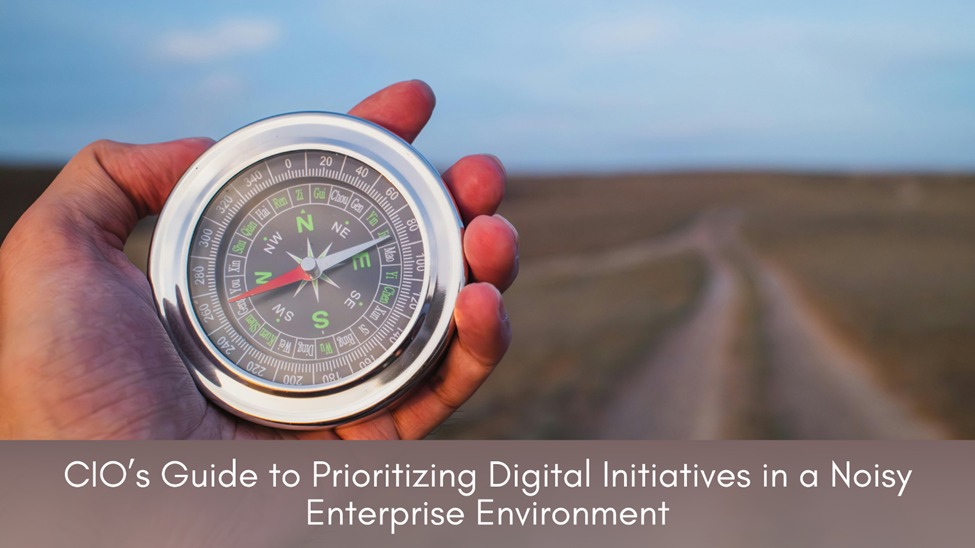
In today’s hyper-digital enterprises, CIOs are bombarded with competing requests: new applications, security upgrades, compliance mandates, AI pilots, and endless “must-have” tools from business units. Amid this noise, one question keeps CIOs awake at night:
How do we prioritize digital initiatives that truly move the business forward without drowning in distractions?
This guide breaks down a CIO’s practical playbook for cutting through enterprise clutter, aligning initiatives with strategy, and ensuring that investments deliver measurable business outcomes.
Why Prioritization Matters More Than Ever
The Cost of Saying “Yes” to Everything
Many enterprises fall into the trap of greenlighting too many initiatives at once. The result? Teams spread too thin, budgets consumed by half-finished projects, and executives frustrated with poor ROI.
According to Gartner, 70% of digital initiatives fail to achieve their intended goals because of poor alignment and lack of prioritization. For CIOs, prioritization isn’t optional, it’s the foundation of execution excellence.
The CIO’s Dilemma in a Noisy Environment
CIOs operate in an enterprise ecosystem filled with:
- Conflicting priorities from different business units
- Legacy system demands competing with innovation projects
- Boardroom pressure for rapid digital transformation
- Limited budgets and resources that can’t support every idea
The challenge is to separate signal from noisewhat drives value versus what drains focus.
The CIO Framework for Prioritizing Digital Initiatives
Here’s a structured approach that leading CIOs adopt:
1. Anchor on Business Strategy
Every initiative should tie directly to strategic objectives whether it’s customer acquisition, operational efficiency, compliance, or innovation. If an initiative doesn’t ladder up to strategy, it doesn’t make the cut.
👉 Learn how Initiatives.app helps align strategy and execution.
2. Score Initiatives with Weighted Criteria
Adopt a transparent scoring model to evaluate initiatives on:
- Strategic alignment
- Revenue impact
- Risk reduction
- Customer experience improvement
- Cost of delay
This ensures prioritization isn’t based on politics, but on data-driven decisions.
3. Balance “Run, Grow, Transform” Investments
CIOs should categorize initiatives into:
- Run: Essential maintenance and compliance
- Grow: Enhancing current business operations
- Transform: Future-focused innovations like AI, automation, or digital platforms
A balanced portfolio reduces risk while keeping innovation alive.
4. Ensure Capacity and Resource Visibility
Even high-value initiatives fail if resources are unavailable. CIOs need real-time visibility into talent capacity, vendor bandwidth, and financial constraints.
👉 Explore our blog on Maximize Talent Utilization in IT Services: Expert Playbook.
5. Continuously Reassess Priorities
Prioritization isn’t a one-time exercise. Market dynamics, regulations, and customer needs evolve CIOs must revisit their initiative portfolio quarterly, if not monthly.
Practical Tools and Techniques CIOs Use
1. Initiative Management Platforms
Modern CIOs no longer rely on spreadsheets. Platforms like Initiatives.app integrate directly into Microsoft Teams, enabling:
- Real-time tracking of initiatives
- Automated dashboards for executives
- Collaboration without platform-hopping
2. Portfolio Dashboards
CIOs should maintain a single version of truth for all initiatives showing costs, risks, timelines, and dependencies at a glance.
3. Scenario Planning
“What if” simulations help CIOs understand trade-offs what happens if you delay a cybersecurity upgrade by six months? Or invest in AI before scaling cloud migration?
4. External Benchmarks
Referencing industry benchmarks and best practices (for example, via LinkedIn discussions) ensures CIOs aren’t prioritizing in isolation.
Common Pitfalls CIOs Must Avoid
1. Prioritizing Based on the Loudest Voice
CIOs often get pressured by vocal stakeholders. Without a structured framework, initiatives risk becoming political decisions.
2. Ignoring Capacity Constraints
Greenlighting more than teams can handle leads to burnout, missed deadlines, and revenue leakage.
3. Underestimating Change Management
Even the right initiative can fail if user adoption is ignored. CIOs must include training and communication in their prioritization framework.
4. Lack of Visibility Across Silos
Without an integrated platform, initiatives often duplicate efforts across departments.
Real-World CIO Scenarios
Case 1 - The BFSI CIO
A banking CIO faces 20 competing requests from regulatory compliance upgrades to AI chatbots. By using a weighted scoring framework, they prioritized compliance (high risk if ignored), followed by customer experience improvements, deferring non-critical innovation pilots.
Case 2 - The IT Services CIO
An IT services CIO with limited delivery bandwidth used Initiatives.app to visualize all ongoing projects. This allowed them to pause low-value internal pilots and reallocate resources to high-revenue client work.
Case 3 - The Manufacturing CIO
Faced with both IoT investments and ERP upgrades, the CIO balanced initiatives into “Run” (ERP stabilization), “Grow” (supply chain digitization), and “Transform” (IoT pilots).
The Future of CIO Prioritization
H3: AI-Augmented Decision Making
CIOs will increasingly use AI to simulate initiative impact, detect risks, and recommend portfolio adjustments automatically.
Governance Without Micromanagement
With real-time dashboards, CIOs can oversee initiatives without constant manual follow-ups.
From Project Delivery to Business Outcomes
Future CIOs won’t just deliver technology they’ll be measured by business impact: revenue growth, customer retention, and innovation velocity.
How Initiatives.app Supports CIOs
Initiatives.app is designed for CIOs who want to bring order to enterprise noise:
- Aligns initiatives directly to strategy
- Provides real-time dashboards inside Microsoft Teams
- Tracks capacity, budgets, and risks automatically
- Enables collaboration without emails and spreadsheets
Conclusion
In a noisy enterprise environment, CIOs who succeed are those who prioritize ruthlessly, align initiatives with strategy, and leverage real-time visibility tools.
By adopting a structured framework and using platforms like Initiatives.app, CIOs can cut through noise, eliminate distractions, and deliver business outcomes that matter.
👉 Book a Personalized Demo Now : https://calendly.com/vishw/30min/invitees
📥 Learn more about features, benefits, and use cases at:
👉 www.initiatives.app
Contact Us : info@whizible.com | +91 855-498-3315
Address : Mrugank, Level 3, Kothrud, Pune, Maharashtra, 411038